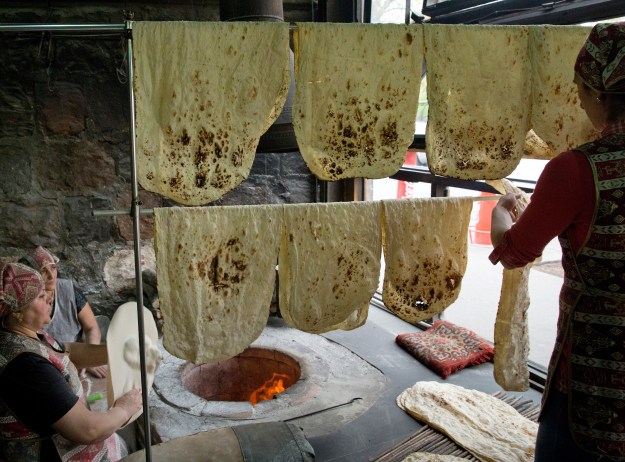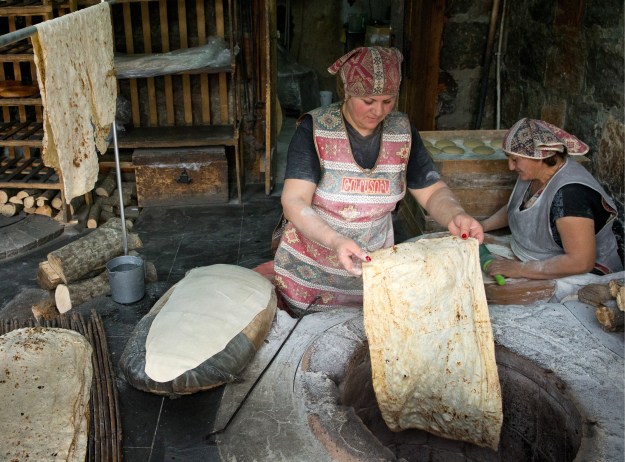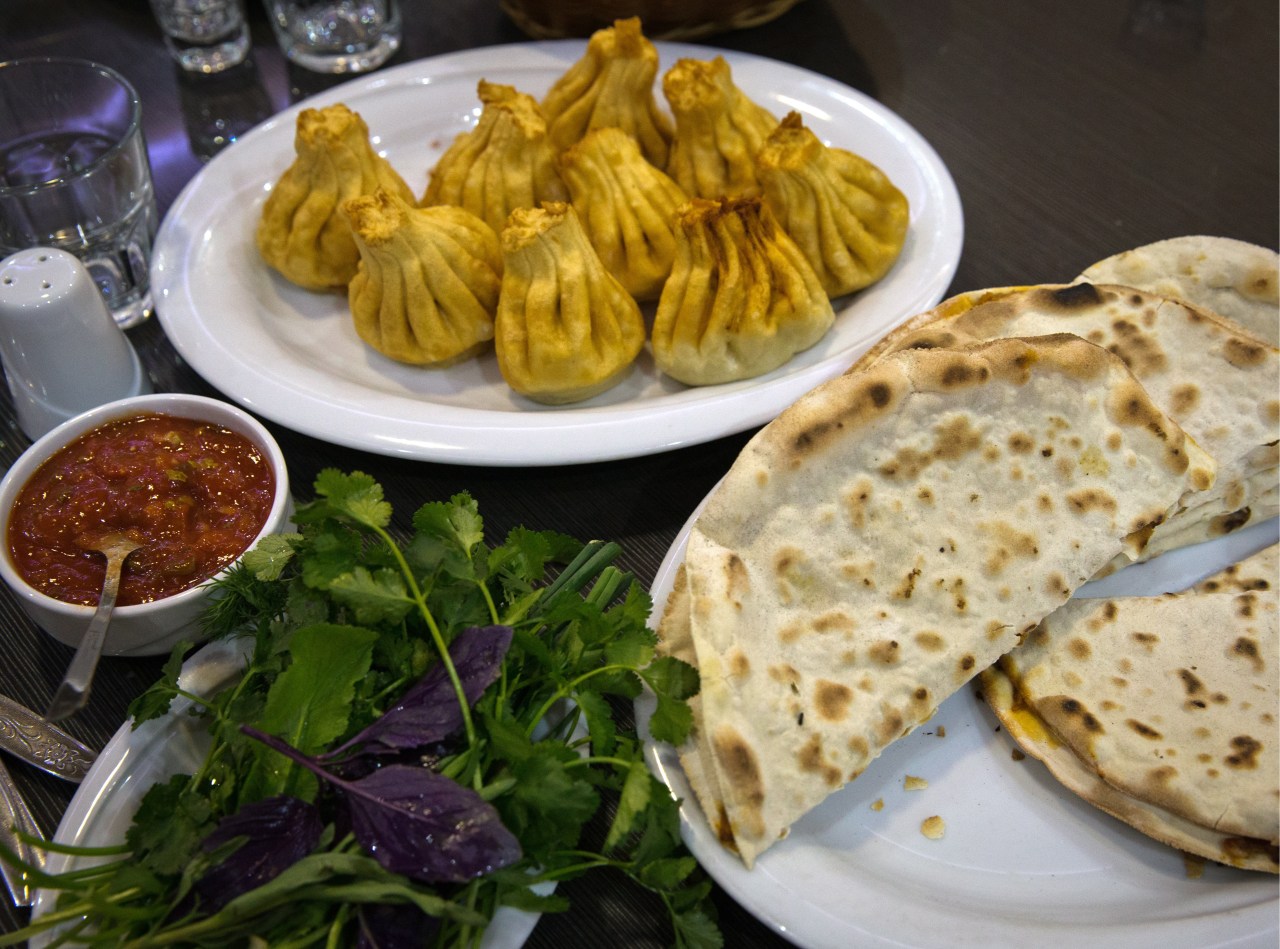We were standing in a three-wall room with streaked, charcoal walls. Wearing gray L.A. Raiders sweatpants, a woman near the wide, doorless entrance used a long pole to stoke a wood fire in a hole in the ground. Ara Zada, an Armenian-American chef; John Lee, a photojournalist; and I had traveled to Armenia to research for our cookbook focusing on lavash, the country’s famous flatbread, and the food it accompanies (which, in Armenia, is practically everything). We were at Ana Tatsoyan’s lavash bakery in Argel, a village known for baking some of Armenia’s best, and we were armed with questions: How do they make the dough? Does the bread contain yeast? Where did the Raiders sweatpants come from?
Before we could ask, three more women sat down around the smoldering fire, which we learned was the bakery’s tonir, a subterranean clay oven used for baking bread. One woman kneaded and portioned dough, one flattened it with a rolling pin, and one used a hook to pull the baked bread out of the oven.
Liana Krikoryan, the woman in the Raiders gear, set the pace for all the other bakers. She took a sheet of dough, flipped it in the air a few times as if she were making pizza, and then draped it over a batat—a large, firm pillow. She then slapped the batat against the inside of the tonir, sticking the dough to the oven’s hot wall. As it baked, she worked on the next round.
The first few batches were no good. The fire was too hot, and the bread came out charred. Still, even before we ate it, we could tell that the lavash in Argel was unlike any we had before. If machine-made lavash is the equivalent of frozen pizza, then we had found the lavash equivalent of a wood-fired Neapolitan pie.
When the women took a break from baking, we joined them for a mid-morning snack, tearing off large pieces of warm lavash to wrap around boiled potatoes. Maybe it was where we were standing, or maybe we were hungrier than we realized, but we were baffled by how much flavor could come from just potatoes and bread. Man may not be able to live on carbs alone, but on that day, we were willing to try.


Lavash through the ages
Bread is an ancient and enduring symbol of Armenian heritage, as is the tonir. Lavash was selected for UNESCO’s intangible cultural heritage list in 2014, and tonirs dating back to the 6th century B.C. have been unearthed in caves in Areni, Armenia’s ancient winemaking region.
Consequently, the country has countless folktales about lavash, many of which are recounted in Irina Petrosian and David Underwood’s 2006 book, Armenian Food: Fact, Fiction, and Folklore. Some are about avoiding bad luck: Never let a child put lavash on his head—it could bring bad weather and money problems. Others are more creative: In one, an Armenian prince escapes starvation during imprisonment, thanks to his lover, who sneaks lavash to him under her clothes. You can guess what happens next.
It has always been women who make the bread, with neighbors getting together to help one another out. This was—and still is—a time to socialize and gossip. It is said that in some villages, Armenian women allow only other married women to join them around the tonir so they can talk about the young singles.
Lavash for every occasion
In 1920, Armenia became part of the Soviet Union. Soviet-Armenian cookbooks, tightly controlled by the government, seldom mention the bread.
What the Soviets failed to understand was that it is more than a side of bread—it has place in nearly every Armenian dish, capable of being transformed into a spoon, a napkin, or a wrap.
It’s an especially important part of the ritual behind eating khash, a rich broth usually made with calves’ hooves that’s common throughout the Middle East and the Caucasus. Dried lavash is crumbled into the broth, and fresh lavash is used to scoop it up like a spoon. In between bites (and vodka toasts, another part of the ritual of eating khash), the bowl is covered with another piece of lavash to “keep it cozy,” said Vahe Keushguerian, a winemaker based in Yerevan.
In warmer weather, lavash becomes useful when eating khorovats, Armenian barbecue cooked over an open fire on metal skewers. Experienced khorovats eaters wrap lavash around the cooked meat and vegetables, removing the skewer as if unsheathing a sword. Lavash can also be used in place of parchment paper to wrap around trout, allowing the fish to steam in its juices as it bakes. When all other forms of inspiration fail, taking a strip of lavash and wrapping it around salty cheese and some scallions, cilantro, dill, parsley, and purple basil makes for a quick meal any time of the day.

The future of lavash
Lavash is ultimately a bread of survival, requiring little more than flour, water, salt, old dough (or yeast), and a hot surface. And its low-tech nature can seem at odds with Yerevan’s booming start-up scene.
At the Tumo Center for Creative Technologies, a free after-school workshop where Armenians study everything from robotics to animation, it’s easy to assume that love for the old ways—and traditional food—could get lost.
But everyone we met was quick to profess a love for the bread, especially the handmade stuff. Factory-produced lavash, they explained, is thinner and more fragile, with a lighter color and a few uniform blisters. Handmade lavash, by contrast, has irregular blisters and more flavor. It also lasts longer, rehydrating easily with a sprinkle of water.
If the next generation of lavash eaters continues to be dedicated to seeking out quality, lavash in Armenia has a strong future. Yet the bread is at its best when it has nothing to do with the future. Instead, it’s about continuing a tradition that goes back centuries, starting with firing up a tonir.